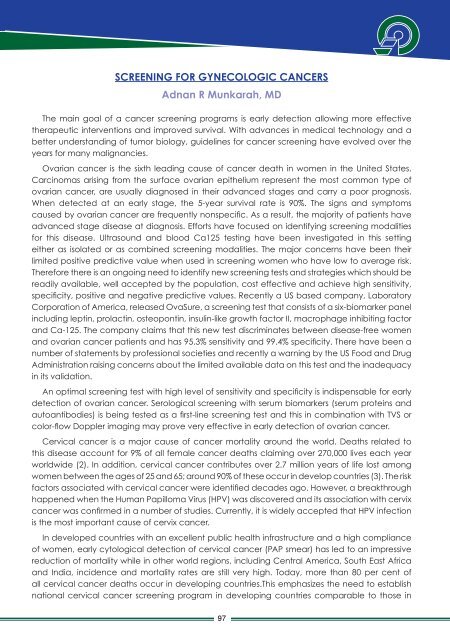The IX t h Makassed Medical Congress - American University of Beirut
The IX t h Makassed Medical Congress - American University of Beirut
The IX t h Makassed Medical Congress - American University of Beirut
You also want an ePaper? Increase the reach of your titles
YUMPU automatically turns print PDFs into web optimized ePapers that Google loves.
SCREENING FOR GYNECOLOGIC CANCERS<br />
Adnan R Munkarah, MD<br />
<strong>The</strong> main goal <strong>of</strong> a cancer screening programs is early detection allowing more effective<br />
therapeutic interventions and improved survival. With advances in medical technology and a<br />
better understanding <strong>of</strong> tumor biology, guidelines for cancer screening have evolved over the<br />
years for many malignancies.<br />
Ovarian cancer is the sixth leading cause <strong>of</strong> cancer death in women in the United States.<br />
Carcinomas arising from the surface ovarian epithelium represent the most common type <strong>of</strong><br />
ovarian cancer, are usually diagnosed in their advanced stages and carry a poor prognosis.<br />
When detected at an early stage, the 5-year survival rate is 90%. <strong>The</strong> signs and symptoms<br />
caused by ovarian cancer are frequently nonspecific. As a result, the majority <strong>of</strong> patients have<br />
advanced stage disease at diagnosis. Efforts have focused on identifying screening modalities<br />
for this disease. Ultrasound and blood Ca125 testing have been investigated in this setting<br />
either as isolated or as combined screening modalities. <strong>The</strong> major concerns have been their<br />
limited positive predictive value when used in screening women who have low to average risk.<br />
<strong>The</strong>refore there is an ongoing need to identify new screening tests and strategies which should be<br />
readily available, well accepted by the population, cost effective and achieve high sensitivity,<br />
specificity, positive and negative predictive values. Recently a US based company, Laboratory<br />
Corporation <strong>of</strong> America, released OvaSure, a screening test that consists <strong>of</strong> a six-biomarker panel<br />
including leptin, prolactin, osteopontin, insulin-like growth factor II, macrophage inhibiting factor<br />
and Ca-125. <strong>The</strong> company claims that this new test discriminates between disease-free women<br />
and ovarian cancer patients and has 95.3% sensitivity and 99.4% specificity. <strong>The</strong>re have been a<br />
number <strong>of</strong> statements by pr<strong>of</strong>essional societies and recently a warning by the US Food and Drug<br />
Administration raising concerns about the limited available data on this test and the inadequacy<br />
in its validation.<br />
An optimal screening test with high level <strong>of</strong> sensitivity and specificity is indispensable for early<br />
detection <strong>of</strong> ovarian cancer. Serological screening with serum biomarkers (serum proteins and<br />
autoantibodies) is being tested as a first-line screening test and this in combination with TVS or<br />
color-flow Doppler imaging may prove very effective in early detection <strong>of</strong> ovarian cancer.<br />
Cervical cancer is a major cause <strong>of</strong> cancer mortality around the world. Deaths related to<br />
this disease account for 9% <strong>of</strong> all female cancer deaths claiming over 270,000 lives each year<br />
worldwide (2). In addition, cervical cancer contributes over 2.7 million years <strong>of</strong> life lost among<br />
women between the ages <strong>of</strong> 25 and 65; around 90% <strong>of</strong> these occur in develop countries (3). <strong>The</strong> risk<br />
factors associated with cervical cancer were identified decades ago. However, a breakthrough<br />
happened when the Human Papilloma Virus (HPV) was discovered and its association with cervix<br />
cancer was confirmed in a number <strong>of</strong> studies. Currently, it is widely accepted that HPV infection<br />
is the most important cause <strong>of</strong> cervix cancer.<br />
In developed countries with an excellent public health infrastructure and a high compliance<br />
<strong>of</strong> women, early cytological detection <strong>of</strong> cervical cancer (PAP smear) has led to an impressive<br />
reduction <strong>of</strong> mortality while in other world regions, including Central America, South East Africa<br />
and India, incidence and mortality rates are still very high. Today, more than 80 per cent <strong>of</strong><br />
all cervical cancer deaths occur in developing countries.This emphasizes the need to establish<br />
national cervical cancer screening program in developing countries comparable to those in<br />
97
















